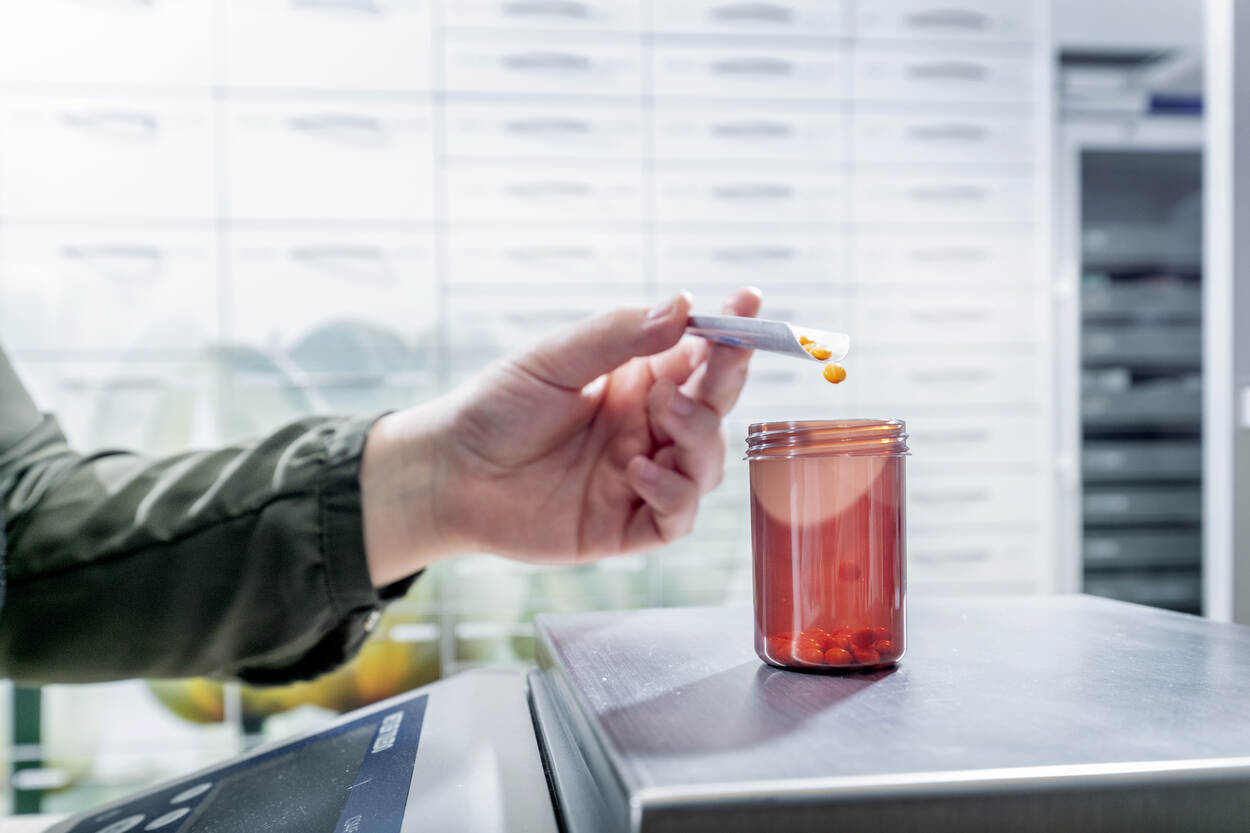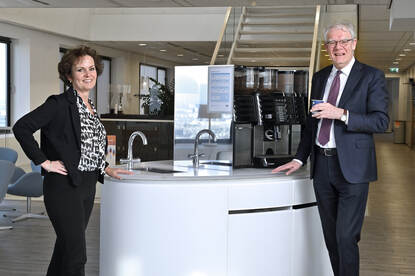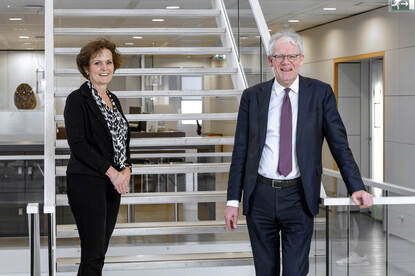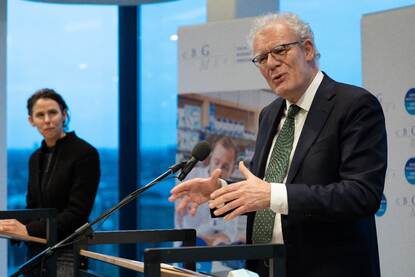In order to be allowed to introduce a medicinal product or vaccine for human use to the market, a pharmaceutical company requires a marketing authorisation. The various procedures that are available for obtaining a marketing authorisation for a medicinal product are discussed more specifically in the chapter ‘Procedures to introduce a medicine to the market’.
European committees
In the following two scientific committees of the European Medicines Agency (EMA), member states join forces in the assessment of medicinal products for human use within the framework of the European centralised procedure: the Committee for Medicinal Products for Human Use (CHMP) and the Pharmacovigilance Risk Assessment Committee (PRAC). Representatives of all EU countries have a seat in these committees. The committees convene every month at the EMA in Amsterdam. In 2021, as in 2020, the committees met remotely via video links due to the restrictions related to the COVID-19 pandemic.
If the Netherlands is the rapporteur, the assessment of the dossier is carried out by a team of MEB employees. The composition of this team depends on the medicinal product and the topics involved in the assessment of the product. The outcomes of the assessment are then put before the Board, after which the Board advises on the proposal with which the Dutch CHMP or PRAC members will enter the discussion in the relevant committees.
The EMA has criteria in place for assigning rapporteurships and co-rapporteurships to ensure that this takes place based on the best available expertise in the member states. There is also room here for countries that have not been rapporteurs that often in the past.
The assignment of co-rapporteurships at the PRAC is different from that of the CHMP: the country that is CHMP Rapporteur automatically becomes the PRAC Co-rapporteur.
Besides the CHMP and the PRAC, there are four other scientific committees for medicinal products for human use in the centralised procedure at the EMA:
- the Committee for Orphan Medicinal Products (COMP);
- the Paediatric Committee (PDCO);
- the Herbal Medicinal Products Committee (HMPC) and
- the Committee on Advanced Therapies (CAT).
Various working groups are active in each scientific committee of the EMA. One example is the Scientific Advice Working Party (SAWP).
The coordination of the European work in connection with the decentralised and mutual recognition procedures has been delegated to the Coordination Group for Mutual Recognition and Decentralised Procedures human (CMDh). The CMDh is a scientific committee of the member states but, like the other committees, convenes at the EMA and is also supported by the EMA.
Rapporteurships and co-rapporteurships assigned via the centralised procedure (CHMP)
The CHMP is also responsible for assessing centralised applications for marketing authorisations of medicinal products.
The number of rapporteurships and co-rapporteurships assigned to the MEB in 2021 decreased slightly compared to the previous year.
Germany was assigned the most rapporteurships and co-rapporteurships in 2021. The MEB followed in second place. Denmark, Austria and Sweden then made up the rest of the top five. Four countries were assigned no rapporteurships and co-rapporteurships.
Rapporteurships and co-rapporteurships assigned
| Co-rapporteur | Rapporteur | |
|---|---|---|
| 2017 | 6 | 7 |
| 2018 | 5 | 18 |
| 2019 | 11 | 24 |
| 2020 | 10 | 19 |
| 2021 | 2 | 21 |
Rapporteurships and co-rapporteurships assigned
| Country | Number |
|---|---|
| Austria | 19 |
| Belgium | 5 |
| Bulgaria | 0 |
| Cyprus | 0 |
| Czech republic | 8 |
| Germany | 35 |
| Denmark | 22 |
| Estonia | 10 |
| Greece | 0 |
| Spain | 8 |
| Finland | 9 |
| France | 18 |
| Croatia | 4 |
| Hungary | 2 |
| Ireland | 12 |
| Iceland | 4 |
| Italy | 6 |
| Lithuania | 8 |
| Luxemburg | 0 |
| Latvia | 3 |
| Malta | 3 |
| Netherlands | 23 |
| Norway | 6 |
| Poland | 16 |
| Portugal | 10 |
| Romania | 4 |
| Sweden | 19 |
| Slovenia | 6 |
| Slovakia | 4 |
| United Kingdom | 0 |
More European cooperation
The MEB also plays an important role in multinational assessment teams, the MNATs. In these teams, a rapporteurship is carried out by several countries. This means that countries with less experience in rapporteurships also have the opportunity to gain experience. Of the 23 CHMP rapporteurships and co-rapporteurships assigned to the MEB in 2021, 9 were assigned as MNATs. In most cases, the participating country took responsibility for assessing the quality aspects of the medicinal product within the MNAT. The number of MNAT collaborations in which the MEB was involved was lower in 2021 than in 2020. However, it nevertheless promoted European cooperation (see also the section on the International Collaboration Program). It also helped the MEB to manage its very high workload, particularly in the area of quality assessment.
Assigned pharmacovigilance rapporteurships and co-rapporteurships (PRAC)
The Pharmacovigilance Risk Assessment Committee (PRAC) plays an important role in terms of supervising the risks of medicinal products for human use in Europe. The PRAC makes recommendations to the CHMP and the CMDh about the risks of medicinal products that are or will be authorised in the European Union.
In 2021, the MEB was assigned slightly more PRAC rapporteurships and co-rapporteurships than in the previous year.
Of the 22 PRAC rapporteurships and co-rapporteurships assigned to the MEB in 2021, 17 were for new active substances. The other rapporteurships and co-rapporteurships concerned generics and biosimilars.
Assigned pharmacovigilance rapporteurships
| Country | Number |
|---|---|
| Austria | 10 |
| Belgium | 0 |
| Bulgaria | 0 |
| Cyprus | 0 |
| Czech republic | 5 |
| Germany | 18 |
| Denmark | 15 |
| Estonia | 0 |
| Greece | 0 |
| Spain | 4 |
| Finland | 10 |
| France | 4 |
| Croatia | 0 |
| Hungary | 0 |
| Ireland | 8 |
| Iceland | 0 |
| Italy | 4 |
| Lithuania | 1 |
| Luxemburg | 0 |
| Latvia | 2 |
| Malta | 2 |
| Netherlands | 22 |
| Norway | 1 |
| Poland | 8 |
| Portugal | 1 |
| Romania | 0 |
| Sweden | 10 |
| Slovenia | 0 |
| Slovakia | 0 |
| United Kingdom | 0 |
Assigned pharmacovigilance rapporteurships
| Other | New substances | |
|---|---|---|
| 2017 | 0 | 14 |
| 2018 | 5 | 11 |
| 2019 | 12 | 19 |
| 2020 | 9 | 11 |
| 2021 | 5 | 17 |
With 22 PRAC rapporteurships and co-rapporteurships, the MEB continues to play a leading role in Europe. The MEB was assigned the most rapporteurships and co-rapporteurships in 2021. Other key players are Germany and Denmark.
The MEB is also responsible for the pharmacovigilance of 100 active substances in a European context. This means that for these substances, the MEB is responsible for analysing data in the European database of suspected adverse reactions (EudraVigilance database) and for identifying signs of possible new or changed risks.
Initiated applications via the decentralised procedure (DCP) and mutual recognition procedure (MRP)
The number of procedures initiated in which the Netherlands was the reference member state (RMS) was similar to 2020.
It is noteworthy that, within Europe, the Netherlands and Germany, with 162 and 248 initiated DCP applications respectively, together coordinate approximately 35% of all DCP and MRP procedures.
Initialised applications via the decentralised procedure (DCP) and mutual recognition procedure (MRP)
| MRP | DCP | |
|---|---|---|
| 2017 | 70 | 230 |
| 2018 | 57 | 211 |
| 2019 | 60 | 235 |
| 2020 | 85 | 174 |
| 2021 | 93 | 162 |
Initialised applications via the decentralised procedure and mutual recognition procedure
| Land | DCP en MRP |
|---|---|
| Austria | 61 |
| Belgium | 7 |
| Bulgaria | 0 |
| Cyprus | 2 |
| Czech republic | 61 |
| Germany | 310 |
| Denmark | 105 |
| Estonia | 25 |
| Greece | 0 |
| Spain | 27 |
| Finland | 35 |
| France | 7 |
| Croatia | 22 |
| Hungary | 73 |
| Ireland | 38 |
| Iceland | 40 |
| Italy | 11 |
| Lithuania | 12 |
| Latvia | 17 |
| Malta | 68 |
| Netherlands | 255 |
| Norway | 6 |
| Poland | 49 |
| Portugal | 116 |
| Romania | 1 |
| Sweden | 135 |
| Slovenia | 18 |
| Slovakia | 9 |
| United Kingdom | 0 |
International Collaboration Program
2021 marked the fourth full year of the International Collaboration Programme (ICP). The aim of the ICP is to share knowledge and experience with medicines authorities from smaller member states to help them take on a larger role within the European network. The 10 participating countries are Bulgaria, Estonia, Iceland, Latvia, Lithuania, Croatia, Malta, Portugal, Slovenia and Slovakia. They receive contributions (as needed) for salaries of newly recruited assessors, support with regard to training (everything was digital in 2021), and customisation for support in ongoing procedures, reviews and peer reviews. Participating countries are now participating fully in MNATs (for centralised applications) and other forms of cooperation. Due to the COVID-19 pandemic, periodic trips to ICP countries have been largely postponed until 2022 and collaboration takes place more in digital form. Some visits did indeed take place to a number of counties in summer 2021 (Malta, Iceland, Slovenia and Slovakia). The emphasis is on assessments of medicinal products for human use, but there is also collaboration with regard to inspections. This was scaled back in 2021 due to the pandemic. International activities have also been expanded for veterinary medicinal products, including activities in the area of antibiotic resistance.
Collaboration between the ICP countries is now reciprocal. There have been several partnerships between ICP countries in relation to courses, training and other types of knowledge exchange. In various instances, this was directly or indirectly facilitated by the ICP. As the programme has not yet been extended with government funds allocated for international cooperation, 2022 will be the last year of the ICP.
Applications via the national procedure
The number of applications submitted via the national procedure (excluding parallel import and including duplex procedures) continues to fluctuate around 60 per year. Most applicants prefer a European procedure (centralised and DCP) so that the product is granted marketing authorisation in several European countries at the same time.
Applications via the national procedure
| 2017 | 2018 | 2019 | 2020 | 2021 | |
|---|---|---|---|---|---|
| Number of applications | 66 | 57 | 67 | 87 | 59 |
National parallel import applications
In contrast to 2019 and 2020, the number of applications for a parallel import marketing authorisation rose in 2021. The total number of parallel import applications was 20% higher in 2021 than in the previous year.
National parallel import applications
| 2017 | 2018 | 2019 | 2020 | 2021 | |
|---|---|---|---|---|---|
| Number of applications parallel import | 445 | 521 | 375 | 316 | 486 |
Number of registered marketing authorisations
The total number of registered marketing authorisations in the Netherlands in 2021 was similar to the previous year.
Number of registered marketing authorisations
| 2017 | 2018 | 2019 | 2020 | 2021 | |
|---|---|---|---|---|---|
| Number of registered marketing authorisations | 14133 | 14288 | 14288 | 13565 | 13452 |
Withdrawals
If a pharmaceutical company submits a request for withdrawal of a marketing authorisation, the MEB examines whether this concerns a critical product. For example, whether there are comparable products in the same group of medicinal products. If this is not the case, the MEB will explore which other possibilities there are to retain the product for Dutch patients. The MEB will do this in consultation with the marketing authorisation holder.
The number of withdrawals has been fairly constant over the years.
Withdrawals
| 2017 | 2018 | 2019 | 2020 | 2021 | |
|---|---|---|---|---|---|
| Number of withdrawals | 1246 | 1209 | 1390 | 1649 | 1150 |
Number of concluded cases (including variations)
The MEB handles hundreds of cases every week. From marketing authorisation applications and applications for indication extensions to smaller variations, such as changing a manufacturer in the dossier, adding an adverse reaction or changing the shelf life of a medicine.
The number of cases concluded by the MEB has increased over the years. The number in 2021 was similar to the previous year.
Number of concluded cases
| 2017 | 2018 | 2019 | 2020 | 2021 | |
|---|---|---|---|---|---|
| Number of concluded cases | 19666 | 25071 | 28959 | 29521 | 29146 |
Scientific advice
By providing scientific advice, the MEB contributes to the responsible development of medicinal products, innovation and early patient access. Scientific advice can concern all aspects of product development, such as clinical or toxicological aspects, as well as regulatory aspects. The advice serves to provide investment security and is a statutory task. There are both national and centralised (European) procedures for providing scientific advice. As a statutory task, providing national advice falls under the direct responsibility of the Board. Centralised scientific advice is prepared by the SAWP and concerns a European consensus. The MEB is active in both European and national scientific advice.
Number of assigned scientific advice requests in Europe involving the MEB
In response to the COVID-19 pandemic, the EMA has introduced an additional urgent advice category. Urgent advice was issued in 79 cases in 2021, with the Netherlands contributing to 12.
Number of assigned scientific advice requests via SAWP
| 2017 | 2018 | 2019 | 2020 | 2021 | |
|---|---|---|---|---|---|
| Number of assigned scientific advice requests via SAWP | 135 | 130 | 142 | 140 | 146 |
Number of national scientific advice requests
The number of national scientific advice requests in 2021 decreased slightly compared to 2020. The decrease in 2020 and 2021 may be due to a shift in priorities in the pharmaceutical industry due to the COVID-19 pandemic. In general, interactions between developers and the MEB were negatively impacted by the lockdown in 2020 and 2021.
The MEB also provides customised advice in which start-ups, small companies and scientific university groups have the possibility to request advice at a reduced rate. Providing this type of advice stimulates innovation at universities and small companies. Scientific groups in particular increasingly turned to the MEB for customised advice in 2021.
As part of this customised advice, a special category for COVID-19 advice was created in response to the COVID-19 pandemic. This advice is intended to support research involving the testing of medicines and vaccines for the potential treatment and prevention of COVID-19. These requests for advice are expedited. Two applications for COVID-19 advice were received in 2021.
As in previous years, the MEB was also actively involved in the drug-rediscovery projects of ZonMw. ZonMw is the Dutch institute that stimulates and finances healthcare research and innovation. With assessments of project applications for research into medicinal products, which are sometimes already used off-label, the MEB contributes to possible on-label use. This provides important advantages for prescribers and patients, but also for the pharmacovigilance. The registered use forms part of the product information, including the patient information leaflet.
In the context of the STARS project (Strengthening Training of Academia in Regulatory Science), the MEB also held a four-day training course for around 120 academics and clinicians at European level. A European workshop to stimulate academic medicinal product development was also organised via STARS in 2021. In addition, previous initiatives, such as providing joint scientific advice with the National Health Care Institute (ZIN) and the Central Committee for Research Involving Human Subjects (CCMO), were continued.
Number of national scientific advice requests
| Scientific advice | Customised advice (including Covid-19 advice) | |
|---|---|---|
| 2017 | 101 | 12 |
| 2018 | 110 | 6 |
| 2019 | 115 | 14 |
| 2020 | 103 | 10 |
| 2021 | 95 | 5 |
MEB-ZIN Parallel Procedures pilot
In the MEB-ZIN (National Health Care Institute) Parallel Procedures pilot, the MEB, together with the umbrella organisations the Association for Innovative Medicines (VIG) and HollandBIO, developed a working method for more parallel procedures for authorisation and reimbursement. This working method was developed to replace the current sequential procedures. This means that the assessment for reimbursement starts while a medicinal product is being assessed for authorisation. As a result, the reimbursement status for the medicinal product is clear shortly after authorisation. To make this possible, the working method is being further developed and tested in a number of pilot procedures (authorisation and reimbursement procedure of a medicinal product).
The report and final report on the pilot were submitted to the Ministry of Health, Welfare and Sports in 2021. The MEB and ZIN commented on the findings and the results of the project were discussed with the Ministry. The Ministry agrees with the conclusions in the report, and emphasises the success of the pilot. The plan is to offer the procedure as a structural alternative to the current reimbursement application procedure. Seven products are now being assessed within the parallel procedure and three procedures have been successfully completed. The pilot procedures show that clarity on the reimbursement status of medicinal products assessed in parallel is available three months earlier. The MEB stresses the importance of the parallel procedure and will, along with the ZIN, take steps in 2022 to permanently include the procedure in its activities.
Adverse reactions
Signalling and assessing adverse reactions of a medicinal product, also when the product has already been authorised, is one of the MEB's core tasks. At the MEB's request, the Netherlands Pharmacovigilance Centre Lareb collects, registers and analyses reports of suspected adverse reactions from medical professionals and patients. Lareb discusses relevant findings from these analyses with the MEB.
Lareb and the MEB discussed 106 analyses of reports of suspected adverse reactions in 2021. This number was much higher than the previous year’s total of 62. One reason for this is the increased COVID-19 assessments, alongside the regular assessments.
Of the 106 analyses, 21 were elaborated for discussion in the Board meetings and 2 in the Medical Practice Committee of the MEB. The other analyses were also followed up through ongoing procedures at the MEB and through the continuous monitoring of the reports.
As stated earlier in this chapter, the MEB is responsible for the signal detection of 100 active substances (or combinations of active substances) in a European context. In addition, the MEB is a PRAC Rapporteur for 109 active substances (or combinations of active substances). For these substances, the MEB assesses all signals of potential new or changed risks. In 2021, the MEB assessed 19 signals in the European context.
The MEB is also responsible for the assessment of Periodic Safety Update Reports (PSUR) of these active substances, within the PSUR Single Assessment (PSUSA) procedure. A PSUR is a comprehensive and critical analysis of the benefit-risk balance of a product. It provides medicines authorities with an update on global experiences with the safety of a product at set intervals after authorisation. The submission of a PSUR is determined through a risk-based approach. The frequency with which PSURs must be submitted varies. The MEB conducted 103 PSUSA assessments on behalf of Europe in 2021.
Lareb signals
| Discussed in board | In Medical Practice Committee | Other | |
|---|---|---|---|
| 2018 | 11 | 3 | 36 |
| 2019 | 16 | 2 | 47 |
| 2020 | 15 | 3 | 44 |
| 2021 | 21 | 2 | 83 |
Direct Healthcare Professional Communication
In the event of urgent and/or important safety issues, healthcare professionals are informed by means of a letter, referred to as a Direct Healthcare Professional Communication (DHPC). A total of 26 DHPCs were sent in 2021.
Direct Healthcare Professional Communications
| 2017 | 2018 | 2019 | 2020 | 2021 | |
|---|---|---|---|---|---|
| Number of DHPC's | 21 | 31 | 29 | 22 | 26 |
Notifications of expected temporary supply problems
The Medicine Shortages and Defects Notification Centre is witnessing a stabilisation of the number of notifications of expected supply problems. The Notification Centre received 3,660 notifications of expected supply problems for a total of 1,835 different medicinal products in 2021. The number of different medicinal products for which supply problems were reported is down by 12% compared with the previous year.
A notification to the Notification Centre does not mean that a shortage will actually occur. Companies increasingly issue a notification as a precaution, while there is no subsequent disruption to supply. The supply problems may also be sufficiently covered by stocks that are still available in the chain.
Around half (49%) of the expected supply problems were caused by delays in production or release of the finished product. Companies also cited this as the main reason in previous years. Supply problems due to an increase in demand also played an important role (25%). In most cases, this increase is due to a supply problem for a similar medicinal product at one or more other companies.
For each notification, the Notification Centre checks whether alternatives are available in the Netherlands. This is the case for many medicinal products, allowing delivery problems to be dealt with. If this is not possible, the MEB and the IGJ will look for another solution together with companies and healthcare providers. Solutions may include permitting packaging from other countries, an alternative medicine from abroad or a pharmacy preparation, or a new marketing authorisation for a medicine that contains the same active ingredient. An appropriate solution was available to patients for 99% of medicinal products that were temporarily unavailable. Nevertheless, actual supply problems create extra work for pharmacists and substitutions can in some cases be annoying for patients.
Notifications of expected temporary supply problems
| 2017 | 2018 | 2019 | 2020 | 2021 | |
|---|---|---|---|---|---|
| Number of notifications of expected shortages | 536 | 1390 | 3070 | 3723 | 3660 |









